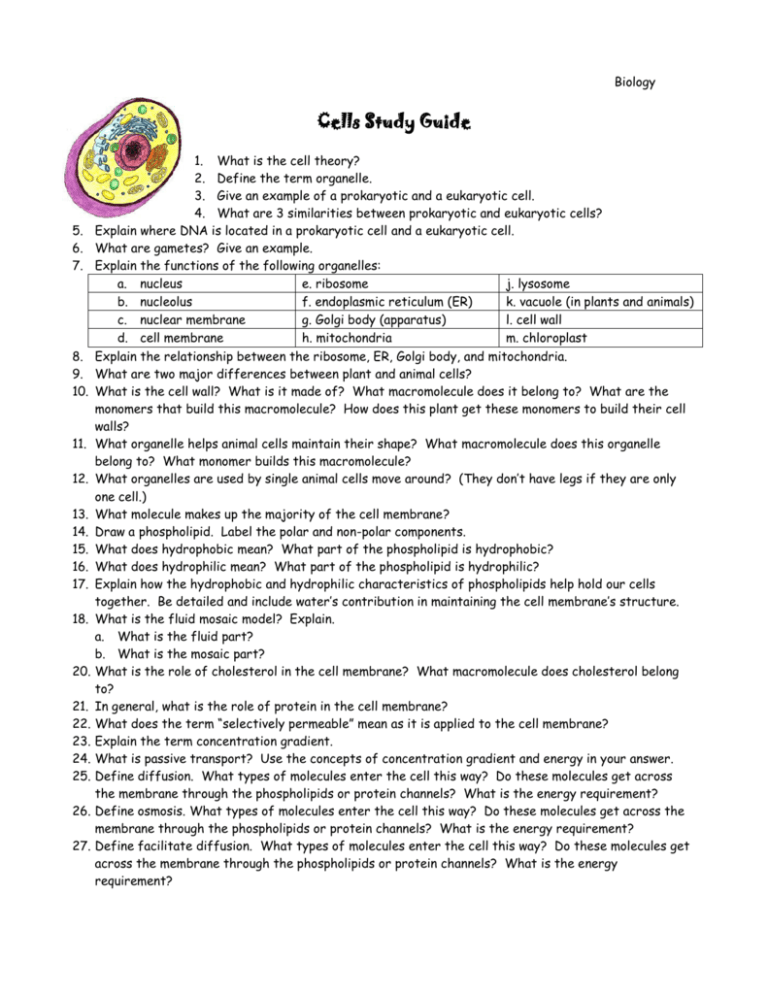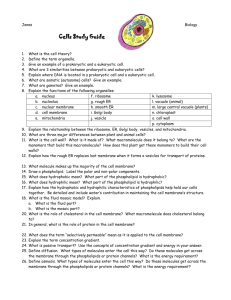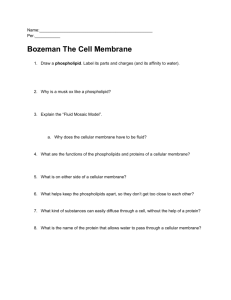Cells Study Guide
advertisement

Biology Cells Study Guide 5. 6. 7. 8. 9. 10. 11. 12. 13. 14. 15. 16. 17. 18. 20. 21. 22. 23. 24. 25. 26. 27. 1. What is the cell theory? 2. Define the term organelle. 3. Give an example of a prokaryotic and a eukaryotic cell. 4. What are 3 similarities between prokaryotic and eukaryotic cells? Explain where DNA is located in a prokaryotic cell and a eukaryotic cell. What are gametes? Give an example. Explain the functions of the following organelles: a. nucleus e. ribosome j. lysosome b. nucleolus f. endoplasmic reticulum (ER) k. vacuole (in plants and animals) c. nuclear membrane g. Golgi body (apparatus) l. cell wall d. cell membrane h. mitochondria m. chloroplast Explain the relationship between the ribosome, ER, Golgi body, and mitochondria. What are two major differences between plant and animal cells? What is the cell wall? What is it made of? What macromolecule does it belong to? What are the monomers that build this macromolecule? How does this plant get these monomers to build their cell walls? What organelle helps animal cells maintain their shape? What macromolecule does this organelle belong to? What monomer builds this macromolecule? What organelles are used by single animal cells move around? (They don’t have legs if they are only one cell.) What molecule makes up the majority of the cell membrane? Draw a phospholipid. Label the polar and non-polar components. What does hydrophobic mean? What part of the phospholipid is hydrophobic? What does hydrophilic mean? What part of the phospholipid is hydrophilic? Explain how the hydrophobic and hydrophilic characteristics of phospholipids help hold our cells together. Be detailed and include water’s contribution in maintaining the cell membrane’s structure. What is the fluid mosaic model? Explain. a. What is the fluid part? b. What is the mosaic part? What is the role of cholesterol in the cell membrane? What macromolecule does cholesterol belong to? In general, what is the role of protein in the cell membrane? What does the term “selectively permeable” mean as it is applied to the cell membrane? Explain the term concentration gradient. What is passive transport? Use the concepts of concentration gradient and energy in your answer. Define diffusion. What types of molecules enter the cell this way? Do these molecules get across the membrane through the phospholipids or protein channels? What is the energy requirement? Define osmosis. What types of molecules enter the cell this way? Do these molecules get across the membrane through the phospholipids or protein channels? What is the energy requirement? Define facilitate diffusion. What types of molecules enter the cell this way? Do these molecules get across the membrane through the phospholipids or protein channels? What is the energy requirement? 28. In a hypotonic environment, is the solute concentration greater outside or inside the cell? 29. If the concentration gradient is too steep, what could happen to an animal or plant cell in a hypertonic environment? 30. Why won’t plant cells undergo cytolysis? 31. In a hypertonic environment, is the solute concentration greater outside or inside the cell? 32. If the concentration gradient is too steep, what could happen to an animal or plant cell in a hypertonic environment? 33. What is plasmolysis? What type of environment would a cell be in to undergo plasmolysis? 34. What is dynamic equilibrium? Use the term isotonic environment in your answer. 35. What is bulk transport? 36. What is the role of vesicles in exocytosis? 37. Discuss how large amounts of food enter the cell and the role of lysosomes in this process. 38. What is active transport? 39. Why does active transport require cell energy? 40. What are 3 reasons why a cell needs to use Na+/K+ pump? Big Ideas: 41. How does the macromolecule unit tie into the cell unit? 42. In general, how does the cell membrane control how the cell interacts with its environment?






